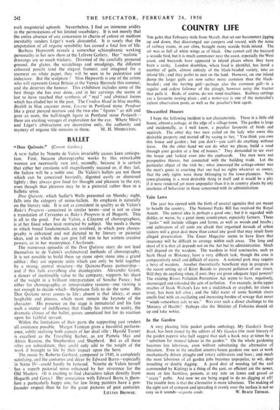BALLET
"Don Quixote." (Covent Garden.) A NEW ballet by Ninette de Valois invariably causes keen anticipa- tion. First, because choreographic works by this remarkable woman are necessarily rare and, secondly, because it is certain that either her creations will magnificently succeed or, if they fail, the failure will be a noble one. De Valois's ballets are not those which can be conceived hurriedly, digested easily or dismissed lightly ; they always give food for thought and pleasure to the eye, even though that pleasure may be in a pictorial rather than in a balletic sense.
Don Quixote, which Sadler's Wells presented on Monday night,
falls into the category of mime-ballets. Its emphasis is naturally on the literary side. It is not as consistent in quality as de Valois's Rake's Progress—conceived in similar terms—and is not so close a translation of Cervantes as Rake's Progress is of Hogarth. This is all to the good. For de Valois, a Cezanne of choreographers, is at her finest when least restricted by subject. She needs a theme in which broad fundamentals are involved, in which pure choreo- graphy is enhanced and not dictated to by literary or pictorial ideas, and in which she can give full rein to her austere creative powers, as in her masterpiece, Checkmate.
The numerous episodes of the Don Quixote story do not lend themselves to de Valois's architectural methods of choreography. It is not possible to build them up stone upon stone into a grand edifice ; they are separate units which can only be held together by a strong, central structure—the Quixote-Panza partnership— and if this fails everything else disintegrates. Alexander Grant, a dancer of inestimable value to the company, supports his share of the weight in a brilliant interim etation of Sancho Panza ; but either for choreographic or interpretative reasons—one viewing is not enough to decide which—Helpmann fails to do the same. His Don Quixote never comes to life ; absent is that idiocy, at once laughable and piteous, which must remain the keynote of the character. His presence on the stage is immaterial and his fate such a matter of indifference that finally his return to sanity, the dramatic climax of the ballet, passes unnoticed but for its reaction upon his faithful servant.
Within the limitations of their parts the supporting cast renders all assistance possible. Margot Fonteyn gives a beautiful perform- ance, subtly realising both aspects of her dual role ; Harold Turner is excellent as the Travelling Barber, as are Pamela May and Alexis Rassine, the Shepherdess and Shepherd. But as all these roles are subordinate, they could only add to the weight of the work if brought to life by their impact upon the hero.
The music by Roberto Gerhard, composed in 1940, is completely satisfying, and the costumes and decor by Edward Burra—especially in Scene IV—could hardly be bettered. Ninette de Valois herself has a superb pictorial sense enhanced by her reverence for the Old Masters. (It is exciting to find characters taken directly from Hogarth and Goya.) Her association with Edward Burra is jhere- fore a particularly happy one, for few living painters have a pro- founder respect than he for the great pictures of past centuries.
LILLIAN BROWSE.


































 Previous page
Previous page